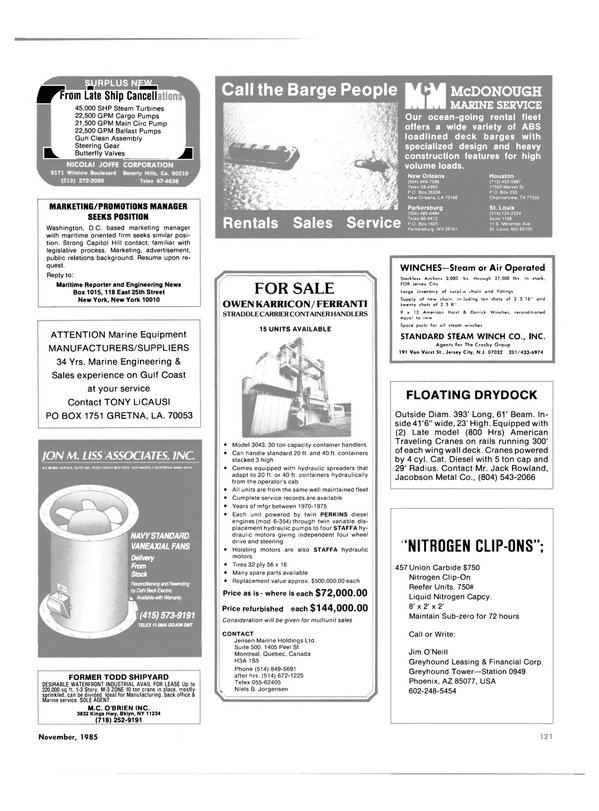
Japan Radio Introduces Two N e w Products—GSC-80 ODARS And JLR-4000 GPS Navigator
Japan Radio Co., Ltd. (JRC) of Tokyo, Japan, has introduced two new products, the JLR-4000 GPS Navigator, and the GSC-80 ODARS (On- Board Data Automatic Recording System).
The GPS/NAVSTAR (Global Positioning System/NAVigation System with Timing and Ranging) system is a completely new system that will use 18 satellites to pinpoint the threedimensional position and speed of any object in the air, on the land or on the sea, anyplace in the world in real time with great accuracy. The system, now being developed in the USA, can use seven satellites, now in orbit. This allows the measurement of positions for about three to five hours a day. Twenty-four-hour service will be available throughout the world in about 1987.
According to Japan Radio Co. president Koji Matsui, the GPS receiver prototype was completed in June 1982, passing a series of careful tests in Japan. Since then, the design has been refined to make the product more compact and more suitable for users in the general aviation, marine shipping and automobile circles. Evaluation testing proved to be entirely satisfactory.
The GPS navigator is said to be one of the most compact, lightweight navigators in the world. Other features are: One-Channel Receiving by Unique Time- Sharing—Since the GPS navigator receives radio signals from four satellites to measure a position, four or five receiving channels would normally be required. However, the unique timesharing system JRC has developed allows the receiver to receive the signals from all four satellites on a single channel for instant position fixing.
Navigator with Various Functions—This GPS receiver determines not only latitude, longitude, elevation, speed and bearing—the basic functions— but it can also indicate such navigational data in memory as destination, bearing and distance to destination, required time to it, offcourse alarm, and so forth.
Many Options—Many powerful optional units, such as a color plotter for color track display, a hard-copy printer for printout of various data, and a remote display unit for displaying the navigational data in a remote place can be connected to the GPS navigator.
The JRC ODARS has been developed to meet the recent demand for automated data communications through the INMARSAT system from ship to shore. The ODARS is an automatic data reporting system to collect various types of onboard data and to automatically transmit the newest data to the shipowner's office on shore through the INMARSAT telex link.
The GSC-80 consists of a multi-data interface (MDI) and a telex channel interface (TCI) which are connected to an existing or new INMARSAT ship earth station.
The GSC-80 can provide data transmissions to shore in the following three modes: (1) Fully automatic data transmission on a time schedule (up to six times per day) without intervention by the operators on the ship and at the shipowner's office.
(2) Semiautomatic data transmission through manual operation of a registered telex terminal at the shipowner's office. (Polling mode to ensure data secrecy.) (3) Manual data transmission through manual operation of the ODARS onboard.
The onboard data received at the shore office is analyzed and processed to send a relevant sailing plan to the ship.
For further literature containing full information on the JLR-4000 GPS Navigator and the GSC-80 ODARS from Japan Radio, Circle 70 on Reader Service Card
Read Japan Radio Introduces Two N e w Products—GSC-80 ODARS And JLR-4000 GPS Navigator in Pdf, Flash or Html5 edition of November 1985 Maritime Reporter
Other stories from November 1985 issue
Content
- BPNAP Marine Lubricants Relocates In N e w Jersey page: 5
- Clemlite® System Offers Economy And Safety page: 5
- Fifth Maritime Prepositioning Ship Delivered By Bethlehem-Beaumont page: 6
- Versatile Vickers Awarded Refit Contracts Worth $15 Million From Canadian Navy page: 6
- Todd-Seattle A w a r d ed $ 6 - M i l l i o n N a v y Contract For Work On Support Ship page: 7
- Oceaneering Uses Signals From GPS Satellites To Position Drilling Rig page: 7
- Newman's Offers N ew Brochure On Complete Line Of Ball Valves page: 8
- Royal Navy Purchases Raytheon Bathy System page: 8
- Africa Ocean Lines Getting First N e w Containerships From East German Shipyard page: 9
- Waller Heads N e w Firm Based In San Diego To Provide Contract Management page: 10
- Foss Initiates New Container Feeder Service page: 10
- Fuel Tech Adds F.A. Hughes As Subsidiary, Amalgamating Combustion Technologies page: 10
- Moon Engineering Expands— Moves To Portsmouth, Va. page: 11
- Ingalls Shipbuilding Christens Another Aegis Missile Cruiser page: 12
- Penn Ship Delivers USNS Denebola To The Navy Three Weeks Early page: 16
- Hartley Marine To Operate Walker General Cargo Terminal In Paducah, Ky. page: 16
- Bailey Controls Forms Marine Market Group To Handle Worldwide Sales page: 18
- Metropolitan Offers N ew Grooved Pipe Fittings page: 18
- Jeffboat, Incorporated Delivers Twin-Screw Towboat 'Alois Luhr' page: 20
- Envirovac Receives Contract To Equip Twelve U.S.C.G. Cutters page: 24
- Canadian Engineers To Hold MariTech '86 In Vancouver, June 5-7 page: 24
- Transamerica Delaval's Deltex Repair Facility Offers Free Color Brochure page: 26
- New Manual Details Tank Protection Against 5,000 Products page: 28
- Jorgensen Company New Licensee For Escher Wyss CP Propellers page: 28
- Blue Streak Industries Delivers First Lift Boat With 110-Foot "legs' page: 30
- Pyramid Pump Offers Brochure On Deepwell Barge Pumps page: 32
- Nissen Metal Marker Readable At 2,100° F page: 32
- SNAME Southeast Section Holds General Meeting page: 32
- Alexander Industries Appointed Microphor Representative page: 40
- Hitachi Zosen To Build Giant Submersible Barge page: 41
- Samson Ocean Introduces H i g h - S t r e n g t h Dock Lines page: 41
- MacGregor-Navire Wins Contracts For RO/RO Ramps In U.K. And India page: 42
- Vikubo Offers Free Brochure On Foam-Filled Floating Fenders page: 42
- ' 85 Sales Of Imperial Survival Suits Nears 100,000—Literature Offered page: 43
- BPNAP Offers Free Color Brochure On Products And Services page: 44
- New Chemical Parcel Barging Service Offered In Port Of N e w York page: 45
- 93rd S N A M E Annual Meeting Fourth International Maritime Exposition page: 50
- Raytheon Adds New Frequency To DSF-6000 Fathometer Depth Sounder page: 79
- High-Performance Bearings Reduce Costs By Extending Dredge Life page: 80
- New Edition Of 'Research Manufacturing, Engineering' Now Available From M.A.N. page: 80
- Ogden Completes Sale Of Avondale Industries Common Stock page: 80
- Systonetics Offers Free Brochure On Automated Project Management Systems page: 81
- P.A.D.D. Co. Opens New Drydock To Begin Shipyard Improvements page: 82
- USS Safeguard Commissioned At Peterson Builders' Sturgeon Bay Yard page: 84
- Nippon Kokan To Build Semi-Submersible Rig For Norwegian Firm page: 85
- Transamerica Delaval Offers Broad Range Of Solenoid Valves page: 85
- Moss Point Marine Will Build Two Fireboats Designed By Nickum & Spaulding For Long Beach page: 86
- Marine Machinery Association Sponsors Government-Industry Forum page: 86
- Brown Announces Organizational Changes At Maritime Administration page: 89
- Bretvin Named President And COO Of Stolt-Nielsen page: 89
- Norcontrol Engine-Room Simulator For Singapore Nearing Completion page: 90
- Fiori Named Director Of Special Services At American President page: 90
- W a t e r w a y Operator Survey Launched page: 90
- Newport News/lntelmach Introduce The IM (Intelligent Machine) Series page: 91
- NRL Names Bradley New Superintendent, Acoustics Division page: 91
- N e w Portable Transmitter Provides Emergency Shutdown Control page: 91
- Duramax Introduces Two N e w Styles Of Tow-Knees page: 91
- New Mono-Hull Form Provides Ultra-Stable Drilling Platform page: 92
- MSI Offers 21 MarineSafety Training Courses For 1986 page: 95
- No Lubrication Required For Falk 'Torus' Couplings page: 97
- Eastern Marine Contracted To Build Scallop Trawler page: 98
- TeleSystems' Compact Communications Unit Approved page: 98
- D r e w AMERGIZE® Tested And Chosen For All Ships In Major Fleet page: 99
- Falk Fluid Couplings Provide xSoft-Touch' page: 99
- VIEWNAV® Offshore Platform Monitoring System Installed In North Sea And Off California page: 100
- MSC Awards $22.3-Million Contract To Trailer Marine page: 101
- Hagglund Introduces New Hydraulic Motor page: 101
- KHD And MWM Form New Diesel Engine Group page: 102
- New X-FLO Steam Compressor Fabricated To Withstand Corrosion page: 102
- Renk Gear System Provides Constant-Frequency Power Generation From Main Engine page: 104
- Oerlikon Introduces N e w Line Of Maintenance And Repair Alloys page: 105
- HydroComp Develops Naval Engineering Software Programs page: 109
- Nineteen N e w Members Elected To American Bureau Of Shipping page: 109
- Almerico Joins Moss Point As Vice President page: 109
- Sperry's New Satellite Communicator Granted Unrestricted Type Approval page: 110
- Raytheon Introduces New Commercial 'IMO' Recording Echo Sounder page: 110
- Navigation Sciences Offers Viewnav® Master Mariner Brochure page: 111
- Norcontrol Wins Contracts For Liquid Cargo Control And Monitoring Systems page: 111
- Free Full-Color Brochure On Monitoring System Offered By Siemens AG page: 111
- Aeroquip Offers Bulletin On International Fluid Connector Identification page: 112
- Bethlehem-Sparrows Point To Begin Work On Navy Ocean Survey Ships page: 112
- New Chesterton Cartridge Seal Meets API 610 Specs page: 112
- Japan Radio Introduces Two N e w Products—GSC-80 ODARS And JLR-4000 GPS Navigator page: 113
- Avondale Christens First Of Five Fleet Oilers Building For Navy page: 119
- Alaska Diesel Electric's 'Lugger' Engines Chosen For N e w Tug page: 122
- Uniden® Offers Three New Electronic Aids page: 122
- Polymer Alloy Extends Icebreaker's Propeller Shaft Bearing Life page: 123


